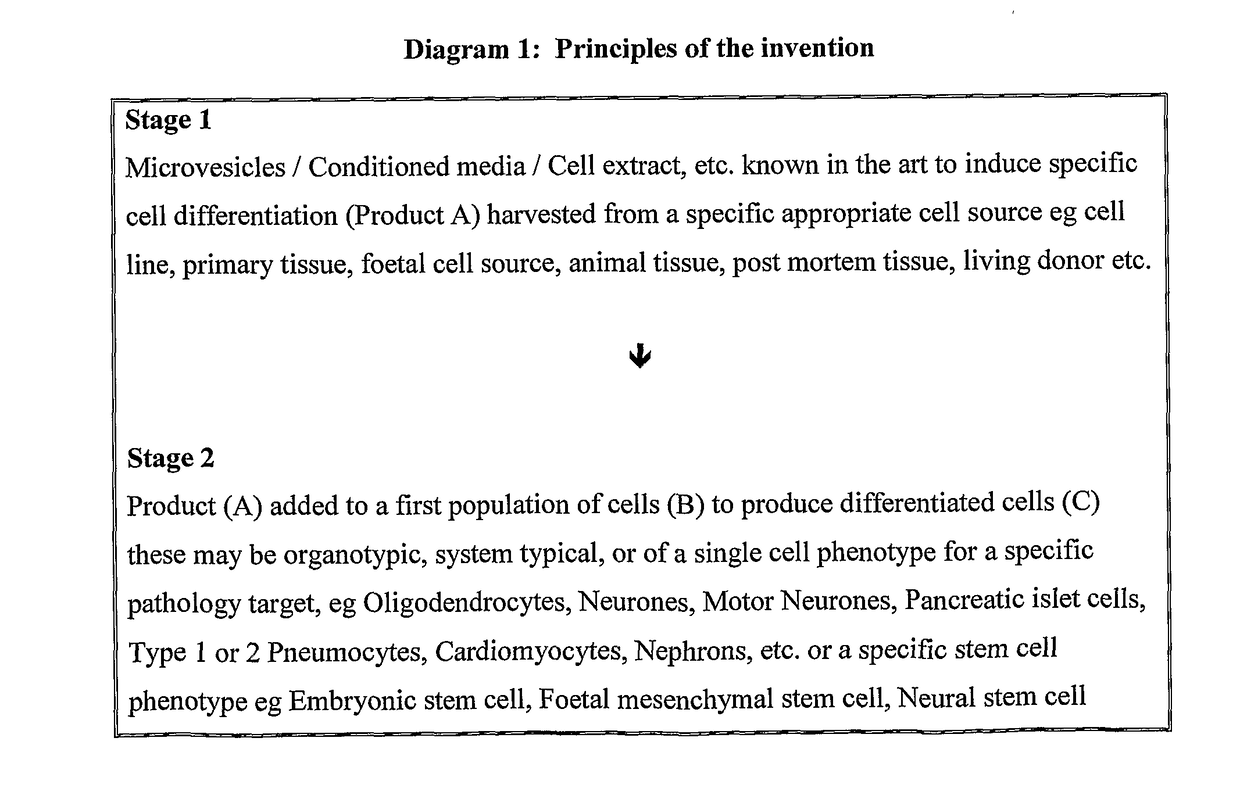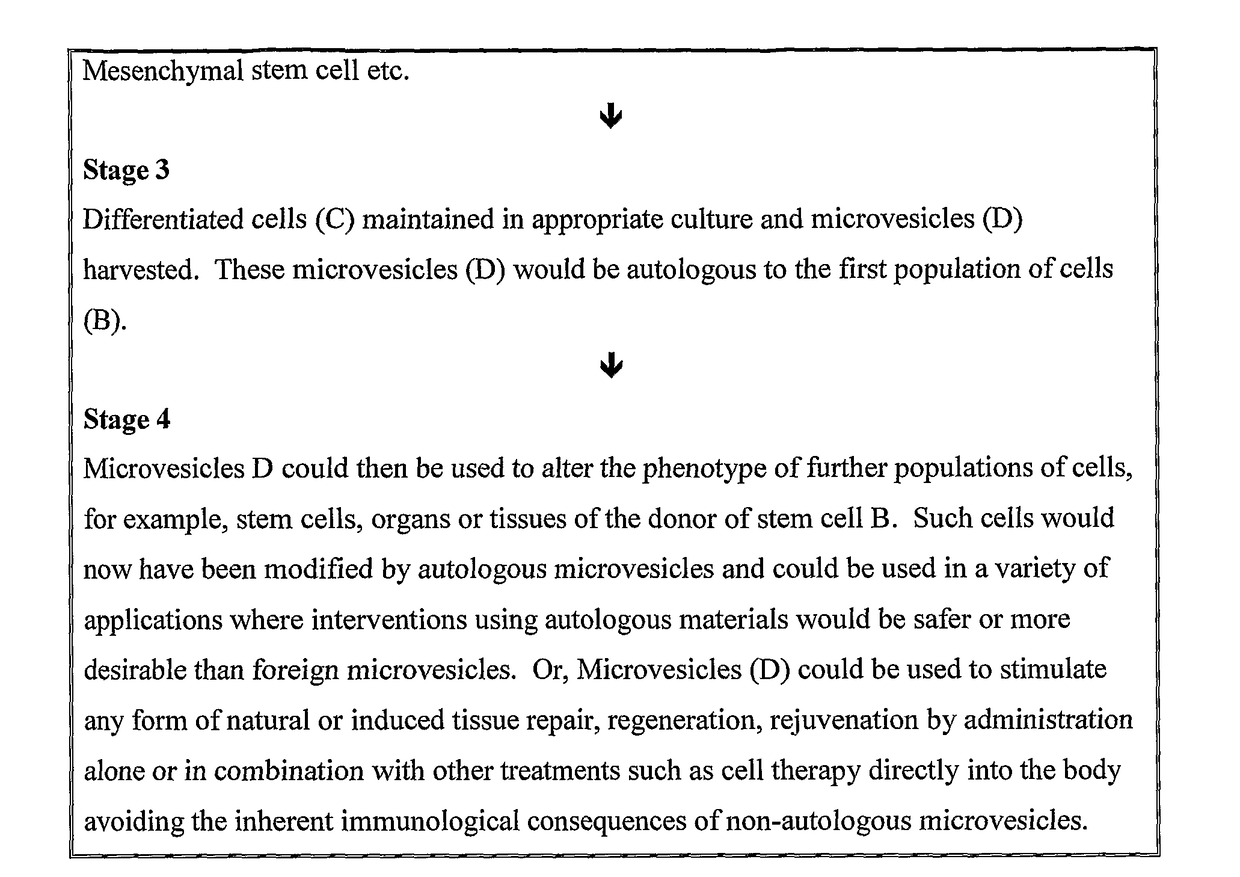Microvesicles
a technology of microvesicles and microvesicles, which is applied in the field of microvesicles, can solve the problems of difficult to obtain difficult to achieve significant numbers of autologous derived microvesicles, and difficult to store. achieve the effect of facilitating uptak
- Summary
- Abstract
- Description
- Claims
- Application Information
AI Technical Summary
Benefits of technology
Problems solved by technology
Method used
Image
Examples
example 1
[0240]Improved Differentiation of Stem Cells Mediated by Autologous Microvesicles Manufactured by a Method of the Invention Compared to Non-Autologous Microvesicles Prepared by Methods Known in the Art.
[0241]Aim
[0242]To test the potential benefit of autologous microvesicles compared to non-autologous microvesicles in inducing stem cells to differentiate to a specific fate. It was hypothesised that the surface membrane properties of microvesicles may influence their efficiency in fusing with recipient cells. Further, that autologous microvesicles may show improved cell fusion and thus be a more powerful stimulant for specific stem cell differentiation.
[0243]Stem Cells
[0244]Stimulated bone marrow mesenchymal stem cells were harvested from peripheral blood of an adult male Hooded Lister rat following mobilisation of these cells using GCSF and plated into a 174 ml plastic culture flask (Falcon) in alpha-mem media with 1% penicillin and streptomycin and 10% foetal calf serum. Cells were ...
example 2
[0258]Autologous Microvesicle Primed Stem Cell Induced Repair in Aged Rat Compared to Existing Non-Autologous Equivalent Methods.
[0259]Having established an advantage to the methods claimed in the invention for autologous microvesicle induced differentiation, their efficacy in an in vivo model was explored. It was hypothesised that non-autologous microvesicle induced differentiation, known in the art may change the surface characteristics of a recipient cell by the nature of their contributed cell membrane. Thus, such stem cells may not be capable of reaching their full potential of repair, regeneration or other reparative functions as many cells may be destroyed by the host immune system.
[0260]The test employed was a cognitive test of spatial memory, the Morris water maze. Aged rats are known to be poor at both learning and recalling this task. In brief the water maze is a plastic tank 1.8 m in diameter filled with 21° C. water. The water is made opaque by the addition of powdered ...
example 3
[0283]Recently, much interest has focused on microvesicles in a variety of areas of biological and medical science as a diagnostic, an inducer of stem cell differentiation and as mediators of various biological effects. All existent technology for cell modification relies on non-autologous microvesicles because autologous microvesicles would require some of the patients' damaged tissues to be removed and cultured in vitro to generate autologous microvesicles. This invention surmounts that issue with a novel two step approach. Further, microvesicle methods currently known in the art could not generate products which could be injected into a host organism as the microvesicles would mostly be destroyed by immune reaction. The invention disclosed in this patent application gets around that problem and provides methods to investigate microvesicle mediated direct repair in an organism. Thus a third example is provided investigating the potential of autologous microvesicles as direct media...
PUM
| Property | Measurement | Unit |
|---|---|---|
| buoyant density | aaaaa | aaaaa |
| diameter | aaaaa | aaaaa |
| diameter | aaaaa | aaaaa |
Abstract
Description
Claims
Application Information
 Login to View More
Login to View More - R&D
- Intellectual Property
- Life Sciences
- Materials
- Tech Scout
- Unparalleled Data Quality
- Higher Quality Content
- 60% Fewer Hallucinations
Browse by: Latest US Patents, China's latest patents, Technical Efficacy Thesaurus, Application Domain, Technology Topic, Popular Technical Reports.
© 2025 PatSnap. All rights reserved.Legal|Privacy policy|Modern Slavery Act Transparency Statement|Sitemap|About US| Contact US: help@patsnap.com


